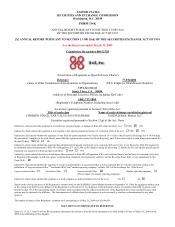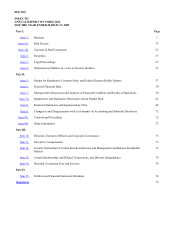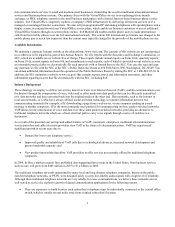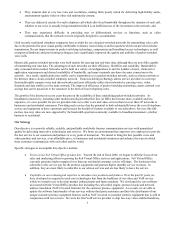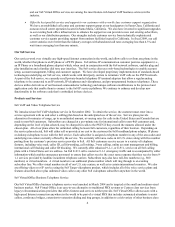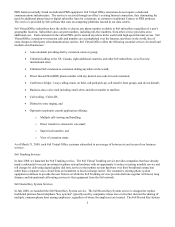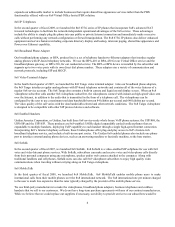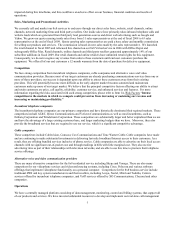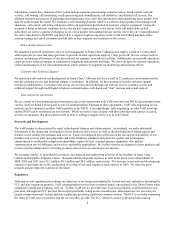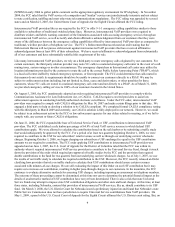8x8 2009 Annual Report Download - page 4
Download and view the complete annual report
Please find page 4 of the 2009 8x8 annual report below. You can navigate through the pages in the report by either clicking on the pages listed below, or by using the keyword search tool below to find specific information within the annual report.2
rich communications services to small and medium-sized businesses, eliminating the need for traditional telecommunications
services and business phone systems. Our primary focus with the Virtual Office service is on replacing private branch
exchange, or PBX, telephone systems in the small business marketplace with a hosted, Internet-based business phone service
solution. 8x8 Virtual Office completely replaces a company’ s PBX infrastructure by delivering all telecom services over a
managed or unmanaged Internet connection. We also sell pre-programmed IP and analog telephones with speakerphones and a
display screen, in conjunction with our Virtual Office service plans, which enable our business customers to access additional
Virtual Office features through on-screen phone menus. 8x8 MobileTalk enables mobile phone users to make international
calls from their mobile phones over the 8x8 international network. The current 8x8 international per minute rate charged to the
mobile phone user is much less expensive than the current rates typically charged by the provider of the mobile phone service.
Available Information
We maintain a corporate Internet website at the address http://www.8x8.com. The contents of this website are not incorporated
in or otherwise to be regarded as part of this Annual Report. We file reports with the Securities and Exchange Commission, or
SEC, which are available on our website free of charge. These reports include annual reports on Form 10-K, quarterly reports
on Form 10-Q, current reports on Form 8-K and amendments to such reports, each of which is provided on our website as soon
as reasonably practical after we electronically file such materials with or furnish them to the SEC. You can also read and copy
any materials we file with the SEC at the SEC’ s Public Reference Room at 450 Fifth Street, NW, Washington, DC 20549. You
can obtain additional information about the operation of the Public Reference Room by calling the SEC at 1.800.SEC.0330. In
addition, the SEC maintains a website (www.sec.gov) that contains reports, proxy and information statements, and other
information regarding issuers that file electronically with the SEC, including 8x8.
Industry Background
The technology we employ to deliver our service, known as Voice over Internet Protocol (VoIP), enables communications over
the Internet through the compression of voice, video and/or other media into data packets that can be efficiently transmitted
over data networks and then converted back into the original media at the other end. Data networks, such as the Internet or
local area networks, or LANs, have always utilized packet-switched technology to transmit information between two
communicating terminals (for example, a PC downloading a page from a web server, or one computer sending an e-mail
message to another computer). IP is the most commonly used protocol for communicating on these packet switched networks.
VoIP allows for the transmission of voice and data over these same packet-switched networks, providing an alternative to
traditional telephone networks which use a fixed electrical path to carry voice signals through a series of switches to a
destination.
As a result of the potential cost savings and added features of VoIP, consumers, enterprises, traditional telecommunication
service providers and cable television providers view VoIP as the future of telecommunications. VoIP has experienced
significant growth in recent years due to:
• Demand for lower cost telephone service;
• Improved quality and reliability of VoIP calls due to technological advances, increased network development and
greater bandwidth capacity; and
• New product innovations that allow VoIP providers to offer services not currently offered by traditional telephone
companies.
In 2009, In-Stat, a market research firm, published data suggesting that revenue in the United States, from business services
such as ours, will grow from $485 million in 2007 to $1.4 billion in 2009.
The traditional telephone networks maintained by many local and long distance telephone companies, known as the public-
switched telephone networks, or PSTN, were designed solely to carry low-fidelity audio signals with a high level of reliability.
Although these traditional telephone networks are very reliable for voice communications, we believe these networks are not
well-suited to service the explosive growth of digital communication applications for the following reasons:
• They are expensive to build because each subscriber's telephone must be individually connected to the central office
switch, which is usually several miles away from a typical subscriber's location;

